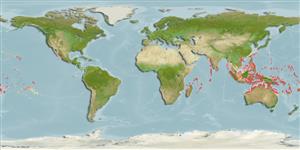Common names from other countries
Environment: milieu / climate zone / depth range / distribution range
Ecologia
marinhas associadas(os) a recifes; intervalo de profundidade 0 - 30 m (Ref. 128797). Tropical; 30°N - 24°S
Indo-Pacific: East Africa to the Tuamoto Islands, north to the Ryukyu Islands, south to New Caledonia.
Tamanho / Peso / Idade
Maturity: Lm ? range ? - ? cm
Max length : 35.0 cm TL macho/indeterminado; (Ref. 5213); common length : 23.0 cm TL macho/indeterminado; (Ref. 9948)
Espinhos dorsais (total) : 11; Raios dorsais (total) : 12 - 14; Espinhos anais: 4; Raios anais : 8 - 9. Body iridescent silvery with dark red or black mark on each scale (Ref. 4201). Spinous portion of dorsal fin black; soft dorsal, anal and caudal fins reddish yellow; pectoral fins pink, pelvic fins white (Ref. 4201). Lower jaw strongly projecting
Inhabits subtidal reef flats and lagoon and seaward reefs to depths of at least 20 m. Found singly or in small groups in coral-rich areas (Ref. 9710). Feeds mainly on benthic crabs and shrimps. Large spine at the corner of preopercle is venomous. It raises or flashes its distinctly marked dorsal fin to startle possible predator (Ref. 48635).
Ciclo de vida ou comportamento de acasalamento
Maturities | Reprodução | Spawnings | Egg(s) | Fecundities | Larvas
Myers, R.F., 1991. Micronesian reef fishes. Second Ed. Coral Graphics, Barrigada, Guam. 298 p. (Ref. 1602)
Status na Lista Vermelha da UICN (Ref. 130435)
CITES (Ref. 128078)
Not Evaluated
Uso pelos humanos
Pescarias: pouco comercial
Ferramentas
Relatórios especiais
Baixar XML
Fontes da internet
Estimates based on models
Preferred temperature (Ref.
115969): 25.5 - 29.3, mean 28.5 (based on 2891 cells).
Índice de diversidade filogenética (Ref.
82804): PD
50 = 0.5312 [Uniqueness, from 0.5 = low to 2.0 = high].
Bayesian length-weight: a=0.01549 (0.00736 - 0.03261), b=2.97 (2.80 - 3.14), in cm Total Length, based on LWR estimates for this (Sub)family-body shape (Ref.
93245).
Nível Trófico (Ref.
69278): 3.6 ±0.59 se; based on food items.
Resiliência (Ref.
120179): Elevada, tempo mínimo de duplicação da população menor que 15 meses (Preliminary K or Fecundity.).
Fishing Vulnerability (Ref.
59153): Low vulnerability (25 of 100).
